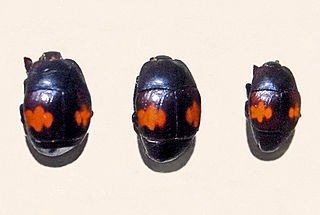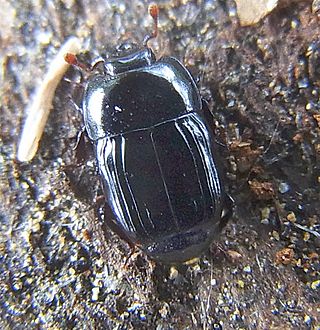
Flower chafers are a group of scarab beetles comprising the subfamily Cetoniinae. Many species are diurnal and visit flowers for pollen and nectar, or to browse on the petals. Some species also feed on fruit. The group is also called fruit and flower chafers, flower beetles and flower scarabs. There are around 4,000 species, many of them still undescribed.

Dicerca is a genus of beetles in the family Buprestidae. It contains the following species:

Mylabris is a genus of beetles in the family Meloidae. It is endemic to the Palearctic realm. The species-rich genus Hycleus was historically confused with Mylabris and have their greatest diversity in the Afrotropics.

Gonocephalum is a genus in the darkling beetle family Tenebrionidae. There are more than 350 described species in Gonocephalum, found on every continent except Antarctica.

Epicauta is a genus of beetles in the blister beetle family, Meloidae. The genus was first scientifically described in 1834 by Pierre François Marie Auguste Dejean. Epicauta is distributed nearly worldwide, with species native to all continents except Australia and Antarctica. Surveys have found the genus to be particularly diverse in northern Arizona in the United States. Few species occur in the Arctic, with none farther north than the southern edge of the Northwest Territories, Canada.

Hycleus is a genus of blister beetle belonging to the Meloidae family found in Africa and Asia. The genus contains over 400 species, which historically have been confused with the genus Mylabris.

Dinidoridae is a small family of hemipteran "true bugs" comprising about sixteen genera and a hundred species the Hemiptera suborder Heteroptera. As a group the family does not have any common name. Until the late 19th century they were generally regarded as a subfamily of Pentatomidae.

Nalassus is a genus of darkling beetles in the family Tenebrionidae. There are more than 70 described species in Nalassus, in the Palearctic and North America.

Saprinus is a genus of clown beetles belonging to the family Histeridae. There are more than 200 described species in Saprinus. They are found on every continent except Antarctica.

Zonitis is a genus of blister beetles in the family Meloidae. The genus was named and described by Johan Christian Fabricius in 1775.

Platysoma is a genus of clown beetles in the family Histeridae. There are more than 80 described species in Platysoma.
Teretrius is a genus of clown beetles in the family Histeridae. There are at least 70 described species in Teretrius.

Uloma is a genus of darkling beetles in the family Tenebrionidae. There are at least 50 described species in Uloma.

Macrosiagon is a genus of wedge-shaped beetles in the family Ripiphoridae. There are more than 20 described species in Macrosiagon. Under the rules of the ICZN, the nomenclatural gender of the genus name is feminine, as it is based on the Greek word "siagon" (σῐᾱγών), for "jaw", which is feminine in gender, despite recent publications erroneously treating the gender as neuter

Phelister is a genus of clown beetles in the family Histeridae. There are more than 90 described species in Phelister.

Gnathoncus is a genus of clown beetles in the family Histeridae. There are more than 20 described species in Gnathoncus.
Trypeticus is a genus of beetles belonging to the family Histeridae.














